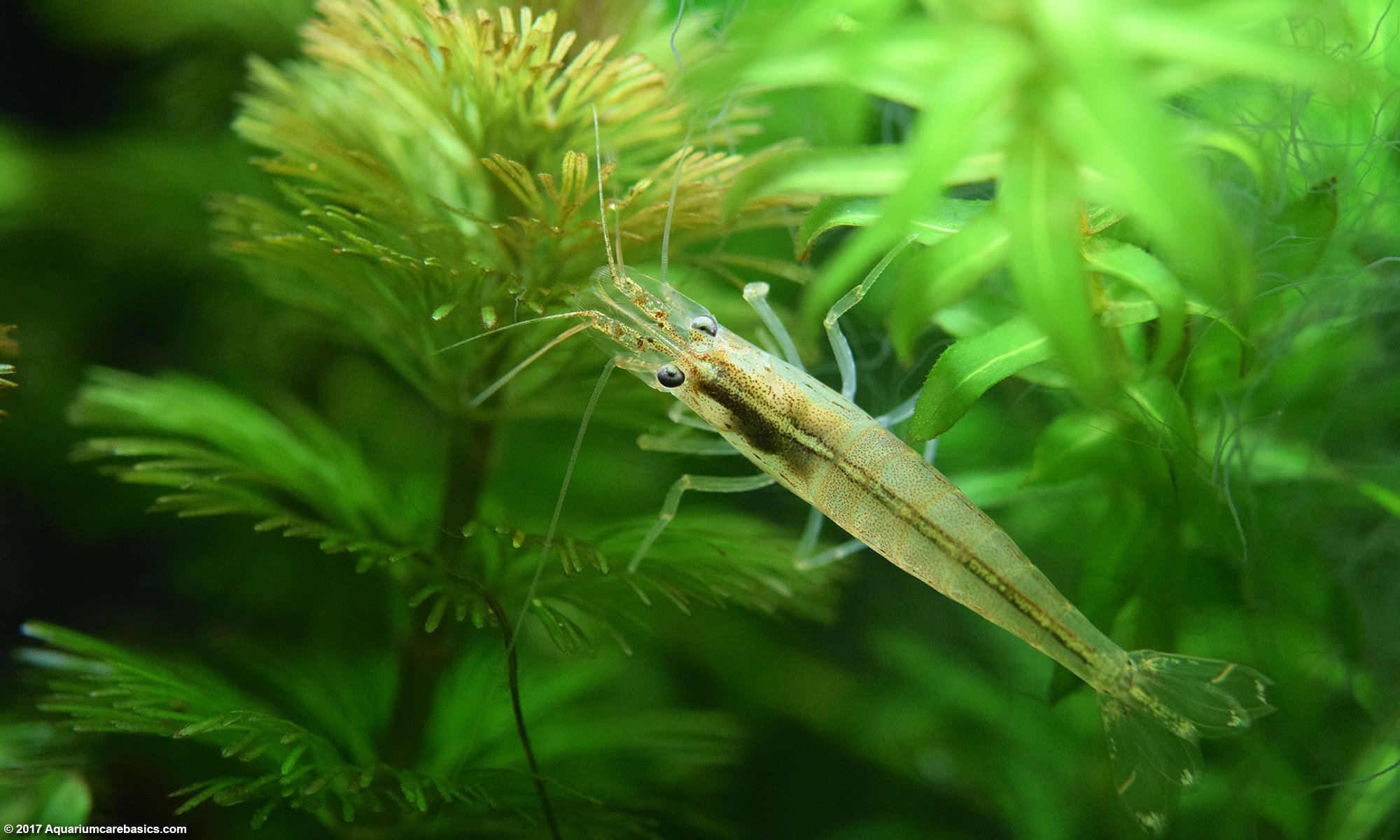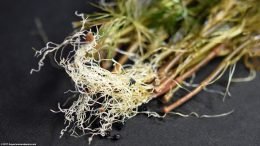A Cabomba plant is becoming a popular freshwater aquarium plant for hobbyists. Cabomba plants are almost always available in stores, and may also be sold under the names Green Cabomba, Carolina Fanwort, Brazilian Fanwort, or simply Fanwort. Cabomba plants can be green or reddish-purple, with Green Cabomba plants being the more popular and more readily available. A Purple Cabomba, sometimes called a Red Cabomba, is somewhat more rare. Purple Cabomba and Red Cabomba plants can also be sold as Purple Fanwort and Red Fanwort. Under the right tank conditions, a Cabomba plant can make an excellent background plant.
When Buying A Cabomba Plant
A Cabomba plant is a stem plant often sold bunched at the base by a tight rubber band. The purpose of the rubber band is to keep all the stems together for display. The chances are Cabomba plants on display will be planted in gravel, although sometimes they will be floating. Look for Cabomba plants with many green stems about 6 inches or more in length. Cabomba leaves should be green, or reddish-purple, bushy and plentiful. There may even be some roots growing from the stems and evidence of new growth. These are all indications that the plant is healthy. And with a little luck, the plant may even have small buds or flowers.
Cabomba Plant Gallery
Cabomba Care: Not Hard, But Not Easy
Green Cabomba care can be pretty tricky. Red and Purple Cabomba care can be trickier still. So Cabomba plants may not be the best choice for beginners. This is especially true if hobbyists are trying to keep it in low light, low tech tanks.
Even under the best conditions, some hobbyists still have a difficult time growing Cabomba plants.
In low light, low tech tanks a Cabomba plant can look good for a couple of days, but the plants often start to break apart and die. The lighting requirements for Green Cabomba plants are beyond standard lighting hoods used by many new hobbyists for their freshwater community tanks. And the lighting requirements for Red Cabomba and Purple Cabomba are more stringent than for the green. The solution for the lighting requirements is not as simple as providing more low lighting for longer hours. Cabomba plants require more watts of light per gallon for longer hours.
In addition to lighting requirements, a Cabomba plant may need liquid fertilizer or root tabs to provide supplements of iron and other necessary minerals. And although not necessary, a Cabomba plant would benefit from CO2 supplements. All these issues combined make Cabomba care more challenging than some of the other starter plants available like Anacharis.
Another thing to think about related to Cabomba care is which species of fish this plant should be kept with. Because it is delicate, it is not the best choice for cichlids, goldfish or other roughens. Also some types of Apple Snails may be interested in eating it.
Water Conditions
Water Parameters: Another Cabomba care issue has to do with aquarium water. A Cabomba plant likes clean tanks with clear gently moving water. If aquarium water moves too quickly, the plant might get jostled around and uprooted.
Aquarium pH: 6.8 – 7.5. Some hobbyists suggest lower is also acceptable.
Water Temperature: Tropical fish range, 72 – 82 degrees Fahrenheit.
Lighting: Medium to High
Tank Size: Small to Large
Stems, Leaves And Roots: Under the right conditions, Cabomba plant stems can grow long with bushy leaves, looking something like a bottle brush. Cabomba plant leaves are soft, delicate and silk-like. As Cabomba plant leaves grow they can be excellent food trappers for aquarium shrimp. Cabomba roots are white, fine and string-like. Cabomba roots are very delicate and can break or tear if uprooted. So if the plant needs to be moved, do not tug the planted stem from the substrate. Instead gently scoop up an area of substrate around the planted stem and let the substrate fall back to the bottom. This way, root damage can be kept to a minimum. If left undisturbed, Cabomba roots can grow into substantial systems relative to the size of the plant.
Planting In Substrate
Planting Cabomba Plant: After getting the plant home, the first thing to do is gently cut the tight rubber band from the base of the stems. Care must be taken to not crack or snap the stems because they can damage easily. Once the stems are free, its a good idea to gently swish the bunch in a bucket of aquarium water. This helps the Cabomba plant shed loose leaves. Its better to let the loose leaves fall off the plant before going into the tank. Loose Cabomba plant leaves tend to float around and create an unsightly mess on power filter intakes or sponge filters.
After swishing away the loose leaves, inspect the Cabomba plant stems where the rubber bands were. If any of the stems seem damaged, simply gently trim the damaged portion away. Its not uncommon to have to trim about a half inch or so away on a couple of stems in a bunch, but generally not much more than that. If broken or cracked stems are planted, they will rot in the tank, so its best to give the plant a fresh start.
Stems In Substrate
Gently plant each stem in an inch or more of nutrient rich plant substrate, an inch or more apart. Its good to plant stems slightly apart to give them room to grow and sway. Be careful not to pack the substrate around the planted stem too tightly because the stem may break. At the same time, make sure the stem is secure because Cabomba plants have a tendency to float around. Its a good idea to plant the longer stems in the back rows and the shorter stems in the front rows. If planted correctly, Cabomba plants can create a nice “dense forest” look. After about a week or so, the plant will take root and be better able to hold itself in place.
Cabomba plant stems can also be used as an accent plant near midground decorations, almost like a tall shrub planted next to a lamp post in the front yard. Small groups of Cabomba plant stems can really look nice to the left or right of a lava rock, for example. With patience and creative thinking, hobbyists get the hang of planting a Cabomba plant pretty quickly.
As A Floating Plant
Floating Cabomba Plant: Its also possible to keep Cabomba as a floating plant. Floating Cabomba is easy. Just drop the stems in the tank and the stems will float near the water surface. Because the stems are closer to the light source, they can grow faster floating as opposed to planted. They can also sprout fine white roots from the stem, and can even flower. But somehow, a floating Cabomba plant does not look as nice as a planted Cabomba.
Trimming Cabomba Plants & Reproduction
For many hobbyists, growing Cabomba plants is a challenge. But for the successful hobbyists who have their Cabomba plants growing like weeds, the growth rate needs to be managed. Otherwise, the plant can potentially outgrow the tank. Also, growing Cabomba plant leaves reaching the surface can block the light for the plant leaves underneath, causing them lower leaves to break apart and die.
Trimming Cabomba plant stems is not difficult. The key to trimming Cabomba is to cut the stems very gently. Be careful to not tug the plant and cause breaking, cracking, excessive shedding or uprooting. And if the trimmings are at least three inches long and look to be in good shape, they can be floated in the water or planted in the substrate. And they will grow into new plants on their own.


